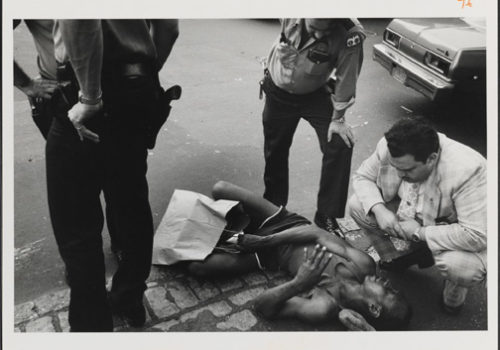An exhibition at the Museum of the City of New York takes a fresh look at the work of an American photographer’s coverage of the New York Police Department in the 1970s.
Disappointed with the loss of two photographers to the commercial world, Edward Steichen told Leonard Freed one day that if he ever went professional, his work would lose all interest. “Be a truck driver.” It was with this amateur, insatiable curiosity that Freed, who joined Magnum in 1970, took an interest in the New York Police Department and the African-American struggle for civil rights. In 1972, to counterbalance the NYPD’s poor public image, the photographer started an investigation into people’s attitude towards the boys in blue. He began by getting to know them better.
Although Freed worked independently on the project for years, it was the Sunday Times, interested in a story on the subject, that first helped Freed gain behind-the-scenes access to the NYPD. Access is really all that a photographer needs: Freed sidled through their precincts, rode out on their patrols, walked their beats, tagged along on calls and raids and arrests. “He did not shy away from being in the middle of it all,” says Sean Corcoran, the exhibition’s curator. “There are very few wide-angle shots. He’s in there as a part of the scenes and the framing makes you feel like you’re there too.”
It was an era of crime, but also of camaraderie. During one of the worst crimewaves the city had ever seen, Freed, through the bonds he had with the police managed to capture scenes that made his work unique. One photograph, showing a policewoman playing Duck, Duck, Goose with neighborhood kids, depicts a New York that is rough, but human nonetheless. This social and cultural aspect endows Freed’s work with a rare objectivity, an objectivity present in his 1980 book Police Work, a publication that is part of the exhibition. “You get a sense of what the job is in totality—the terror, the violence, the horror, and sometimes the joy,” says Corcoran. “It’s a real accomplishment. Leonard Freed’s work should be an inspiration for the current generation of photojournalists.” Photo reports on today’s police, the curator finds, are either too reserved or too sensationalist.
Jonas Cuénin
Leonard Freed, Police Work
Through March 18, 2012
Museum of the City of New York
1220 Fifth Avenue
New York
(212) 534-1672
















